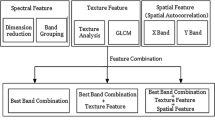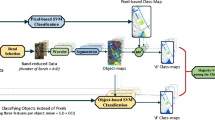Abstract
Different methods of using spatial information in image classification are presented. One approach is to quantify image texture to produce features for use in classifiers, and there are various methods with adjustable parameters for texture quantification. The produced features are numerous and are in different discriminating image classes. Therefore, there is a need for selecting their optimum combination, or to alternatively create a set of features that abstract their class discernibility. Inspired by spectral normalized difference indices, the concept of the spatio-spectral index is introduced in this article to produce indices from a series of spatial features created from image spectral bands. In the proposed method, the produced spatio-spectral indices for each class are used as the abstract of spatial features. Along with the image spectral bands, they are used as new feature forms for supervised classification. Features with maximum and minimum values in each class were selected after production of the average vector in the feature space, and the removal of features with a small variation range. Next, non-repetitive band pairs were selected and spatio-spectral indices were produced. Using this method, the number of selected spatial features was at most twice the number of classes and was used to produce spatio-spectral indices. Use of the produced features in classification improves classification accuracy significantly (about 30% and 6% in the two test images used here) by enhancing class discrimination and decreasing computational time. This method is also explicit and direct, with no need to use iterative optimization processes.











Similar content being viewed by others
References
Ashoori, H. (2010). Generating image-based features for improving classification accuracy, M.S. Thesis, K.N. Toosi University of Technology.
Baret, F., Guyot, G., & Major, D. (1990). TSAVI: A vegetation index which minimizes soil brightness effects on LAI or APAR estimation. In 12th Canadian symposium on remote sensing and IGARSS, Vancouver, Canada.
Castleman, K. R. (1996). Digital image processing. Englewood Cliffs: Prentice-Hall.
Clevers, J. G. P. W. (1988). The derivation of a simplified reflectance model for the estimation of leaf area index. Remote Sensing of Environment, 35, 53–70.
Crippen, R. E. (1990). Calculating the vegetation index faster. Remote Sensing of Environment, 34(1), 71–73.
Gupta, R. P., Tiwari, R. K., Saini, R. K., & Srivastava, N. (2013). A simplified approach for interpreting principal component images. Advances in Remote Sensing, 2(02), 11.
Haralick, R. M., Shanmugam, K., & Dinstein, I. (1973). Textural features for image classification. IEEE Transactions on Systems, Man and Cybernetics, 3(6), 610–621.
Huang, X., & Zhang, L. (2011). A multidirectional and multiscale morphological index for automatic building extraction from multispectral GeoEye-1 imagery. Photogrammetric Engineering & Remote Sensing, 77(7), 721–732.
Huang, X., & Zhang, L. (2012). Morphological building/shadow index for building extraction from high-resolution imagery over urban areas. IEEE Journal of Selected Topics in Applied Earth Observations and Remote Sensing, 5(1), 161–172.
Huete, A. R. (1988). A soil-adjusted vegetation index (SAVI). Remote Sensing of Environment, 25, 295–309.
IEEE GRSS Data Fusion Contest. (2014). Online: http://www.grss-ieee.org/community/technical-committees/data-fusion/.
Jordan, C. F. (1969). Derivation of leaf area index from quality of light on the forest floor. Ecology, 50(4), 663–666.
Kaufman, Y. J., & Tanre, D. (1992). Atmospherically resistant vegetation index (ARVI) for EOS-MODIS. IEEE Transactions on Geoscience and Remote Sensing, 30(2), 261–270.
Leguizamon, S. (1996). Characterization of texture in remotely sensed images by using the wavelet transform. In 4th International symposium on high mountain remote sensing cartography.
Mallat, S. G. (1989). A theory for multiresolution signal decomposition. IEEE Transactions on Pattern Analysis and Machine Intelligence, 11, 674–693.
Myint, S. W., Lam, N. S. N., & Tyler, J. M. (2004). Wavelets for spatial feature discrimination: Comparisons with fractal, spatial autocorrelation, and spatial co-occurrence approaches. Photogrammetric Engineering & Remote Sensing, 70(7), 803–812.
Pinty, B., & Verstraete, M. M. (1991). GEMI: A non-linear index to monitor global vegetation from satellites. Vegetatio, 101, 15–20.
Pratt, W. K. (2007). Digital image processing (4th ed.). London: Wiley.
Qi, J., Chehbouni, A., Huete, A. R., & Kerr, Y. H. (1994). Modified soil adjusted vegetation index (MSAVI). Remote Sensing of Environment, 48, 119–126.
Richardson, A. J., & Wiegand, C. L. (1977). Distinguishing vegetation from soil background information. Photogrammetric Engineering and Remote Sensing, 43, 1541–1552.
Theodoridis, S., & Koutroumbas, K. (2009). Pattern recognition. Amsterdam: Elsevier.
Acknowledgements
The authors would like to thank Telops Inc. (Québec, Canada) for acquiring and providing the data used in this study. We would like to acknowledge IEEE GRSS Image Analysis and Data Fusion Technical Committee and Dr. Michal Shimoni (Signal and Image Centre, Royal Military Academy, Belgium) for organizing the 2014 Data Fusion Contest. We also thank the Centre de Recherche Public Gabriel Lippmann (CRPGL, Luxembourg) and Dr. Martin Schlerf (CRPGL) for their contribution of the Hyper-Cam LWIR sensor, and Dr. Michaela De Martino (University of Genoa, Italy) for her contribution to data preparation.
Author information
Authors and Affiliations
Corresponding author
Additional information
Publisher's Note
Springer Nature remains neutral with regard to jurisdictional claims in published maps and institutional affiliations.
About this article
Cite this article
Ashoori, H., Valadan Zoej, M.J. & Sahebi, M.R. Introduction of Spatio-Spectral Indices for Using Spatial Data in Multispectral Image Classification. J Indian Soc Remote Sens 47, 1003–1017 (2019). https://doi.org/10.1007/s12524-019-00960-4
Received:
Accepted:
Published:
Issue Date:
DOI: https://doi.org/10.1007/s12524-019-00960-4




